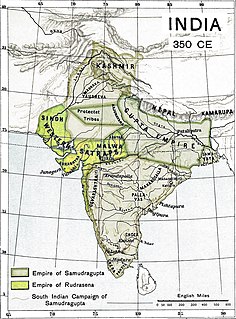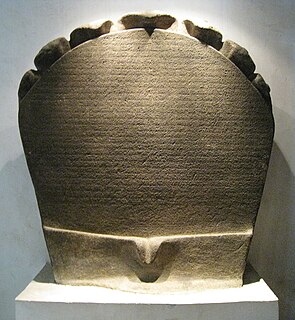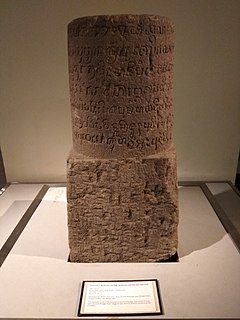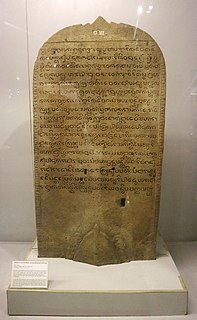
The Majapahit was a Javanese Hindu-thalassocratic empire in Southeast Asia, based on the island of Java, that existed from 1293 to circa 1527. Majapahit reached its peak of glory during the era of Hayam Wuruk, whose reign from 1350 to 1389 was marked by conquest which extended through Southeast Asia. His achievement is also credited to his prime minister, Gajah Mada. According to the Nagarakretagama (Desawarñana) written in 1365, Majapahit was an empire of 98 tributaries, stretching from Sumatra to New Guinea; consisting of present-day Indonesia, Singapore, Malaysia, Brunei, southern Thailand, East Timor, southwestern Philippines, although the scope of Majapahit sphere of influence is still the subject of debate among historians. The nature of Majapahit relations and influences upon its overseas vassals, also its status as an empire are still provoking discussions.

The kris or keris in Indonesian languages, is an Indonesian asymmetrical dagger with distinctive blade-patterning achieved through alternating laminations of iron and nickelous iron (pamor). The kris is famous for its distinctive wavy blade, although many have straight blades as well. Kris is also a symbol of power and of ethnic pride in most communities in Southeast Asia. Kris is also one of the weapons commonly used in pencak silat martial art, which is also native to the region.

Gajah Mada(ꦒꦗꦃꦩꦢ) was, according to Old Javanese manuscripts, poems and mythology, a powerful military leader and Mahapatih or Prime Minister of the Javanese empire of Majapahit, credited with bringing the empire to its peak of glory. He delivered an oath called Sumpah Palapa, in which he vowed to live ascetic until he had conquered all of the Southeast Asian archipelago of Nusantara for Majapahit. In modern Indonesia, he serves as an important national hero, a symbol of patriotism and national unity. During his reign the Hindu epics, the Ramayana and the Mahabharata, became ingrained in the culture and worldview of the Javanese through the performing arts of wayang kulit.

Hayam Wuruk, also called Rajasanagara, Pa-ta-na-pa-na-wu, or Bhatara Prabhu, (1334–1389), was a Javanese Hindu King from the Rajasa Dynasty and the fourth monarch of the Indianised Majapahit Empire. Together with his prime minister Gajah Mada, he reigned the empire at the time of its greatest power. During his reign the Hindu epics, the Ramayana and the Mahabharata, became ingrained in the culture and worldview of the Javanese through the wayang kulit. He was preceded by Tribhuwana Wijayatunggadewi and succeeded by his son-in-law Wikramawardhana. Most of the accounts of his life were taken from Nagarakretagama and Pararaton.

Malang is a city in the Indonesian province of East Java. It has a history dating back to the age of Singhasari Kingdom. It is the second most populous city in the province, with a population of 887,443 according to the 2016 estimation. Its metro area is home to 3,663,691 inhabitants spread across two cities and 22 districts. Malang is the third largest city by economy in East Java, after Surabaya and Kediri, with an estimated 2016 GDP at Rp44.30 trillion.

The Medang Kingdom or Mataram Kingdom was a Javanese Hindu–Buddhist kingdom that flourished between the 8th and 11th centuries. It was based in Central Java, and later in East Java. Established by King Sanjaya, the kingdom was ruled by the Sailendra dynasty.

The Western Satraps, Western Kshatrapas, or Kshaharatas were Indo-Scythian (Saka) rulers of the western and central part of India. The Western Satraps were contemporaneous with the Kushans who ruled the northern part of the Indian subcontinent and were possibly their overlords, and the Satavahana (Andhra) who ruled in Central India. The power of the Saka rulers started to decline in the 2nd century CE after the Saka rulers were defeated by the Emperor Gautamiputra Satakarni of the Satavahana dynasty. Later the Saka kingdom was completely destroyed by Chandragupta II of the Gupta Empire in the 4th century CE.

The Nagarakretagama or Nagarakṛtāgama, also known as Desawarnana or Deśavarṇana, is an Old Javanese eulogy to Hayam Wuruk, a Javanese king of the Majapahit Empire. It was written on lontar as a kakawin by Mpu Prapanca in 1365. The Nagarakretagama contains detailed descriptions of the Majapahit Empire during its greatest extent. The poem affirms the importance of Hindu–Buddhism in the Majapahit empire by describing temples and palaces and several ceremonial observances.

King Sanjaya of Mataram or in complete stylized name known as Rakai Mataram Sang Ratu Sanjaya was the founder of Mataram Kingdom during the eighth century. His name was revealed in the AD 732 Sanskrit Canggal inscription carved in a stone found at Gunung Wukir temple that stood on Wukir or Ukir hill on the southern Kedu Plain in Central Java.

The Sunda Kingdom was a Sundanese Hindu kingdom located in the western portion of the island of Java from 669 to around 1579, covering the area of present-day Banten, Jakarta, West Java, and the western part of Central Java. The capital of the Sunda Kingdom moved several times during its history, shifting between the Galuh (Kawali) area in the east and Pakuan Pajajaran in the west.

The Batutulis inscription is an ancient Sunda Kingdom inscription dated 1533, located at Batutulis village, South Bogor, West Java. Batutulis inscription is located in the ancient site of the capital Pakuan Pajajaran, Batutulis means 'inscribed stone', it is this stone, still in situ, which gave name to the village. The complex of Batutulis measures 17 x 15 metres. Several other inscribed stones from Sunda Kingdom also located in this location. The inscription was written in Old Sundanese language. The Batutulis inscriptions were created in 1533 by king Surawisesa to honor and commemorate his late father, the great king Sri Baduga Maharaja or known as Ratu Haji Pakuan Pajajaran Sri Sang Ratu Dewata. Sri Baduga Maharaja is also known in local tradition as King Siliwangi.

The Padang Roco Inscription, in Indonesian Prasasti Padang Roco, is an inscription dated 1286 CE, discovered near the source of Batanghari river, Padangroco temple complex, Nagari Siguntur, Sitiung, Dharmasraya Regency, West Sumatra, Indonesia.

Telaga Batu inscription is a 7th-century Srivijayan inscription discovered in Sabokingking, 3 Ilir, Ilir Timur II, Palembang, South Sumatra, Indonesia, around the 1950s. The inscription is now displayed in National Museum of Indonesia, Jakarta, with inventory number D.155. In previous years, around thirty Siddhayatra inscriptions were discovered around Southern Sumatra, all concerning the Siddhayatra journey of Dapunta Hyang Sri Jayanasa, that, according to Kedukan Bukit Inscription took place around the year 605 Saka. Today all of these Siddhayatra inscriptions are stored in the National Museum of Indonesia.

The Kingdom of Bali was a series of Hindu-Buddhist kingdoms that once ruled some parts of the volcanic island of Bali, in Lesser Sunda Islands, Indonesia. With a history of native Balinese kingship spanning from the early 10th to early 20th centuries, Balinese kingdoms demonstrated sophisticated Balinese court culture where native elements of spirit and ancestral reverence combined with Hindu influences – adopted from India through ancient Java intermediary – flourished, enriched and shaped the Balinese culture.
Kaladi inscription is a series of Javanese inscriptions engraved on copper plates dated from the year 831 Saka or 909 CE originated from the Medang Mataram kingdom period. It was written in the form of prose in standard Kawi script with some variations, and using the Old Javanese language. This inscription was carved on copperplate totaling 10 plates, however two plates are missing; the plate numbers 3 and 5. Today the 8 plates of Kaladi inscriptions are stored in the National Museum of Indonesia in Jakarta with inventory number E71.

Munggu Antan inscription is an inscription in the form of a stone stele found in the village of Bulus, Purworejo Regency, which was once included in the Kedu Residency. This inscription contains the designation of the village Munggu Antan as a sima dedicated to a temple in Gusali, and it is written in Sanskrit. This inscription was issued by Sang Pamegat Munggu and his younger sister Sang Hadyan Palutungan, who was also the wife of Sang Dewata at Pastika, at the behest of Sri Maharaja Rake Gurunwangi, dated 808 Saka or 887 CE.
Sitopayan II inscription is an inscription written in Proto Batak language and using Old Batak characters. The inscription was found at the Biaro (temple) Si Topayan, in Sitopayan village, Portibi District, North Padang Lawas Regency, North Sumatra Province, Indonesia. The inscription consists of two short lines, written on a horizontal side of the base of a stone idol. F.D.K. Bosch thought that this inscription was made in the 13th century CE, based on the shape and characteristics of the script.

Gajah Mada inscription also known as Singhasari inscription, is an inscription written in old Javanese script, dated to 1273 Saka or corresponds to 1351 CE from Majapahit period, discovered in Singosari district, Malang Regency, East Java. The inscription is now preserved in National Museum of Indonesia in Jakarta under inventory number D 111.
Lubuk Layang inscription, also known as Kubu Sutan inscription, is an inscription found in 1970 in Kubu Sutan, Lubuk Layang, Rao Selatan district, Pasaman Regency, of West Sumatra, Indonesia.

The history of Sunda Kingdom spanned almost a millennium, between 7th to 16th century. It is not sure however, whether the Sunda Kingdom was actually a continuous polity or not, nor whether its rulers belongs to a single continuous lineage of dynasty or not. This is because the scarcity of evidences, historical records and archaeological findings that plausibly connected to this kingdom.
















